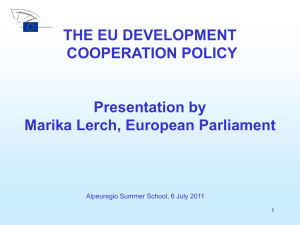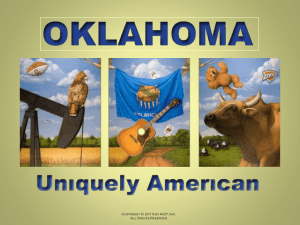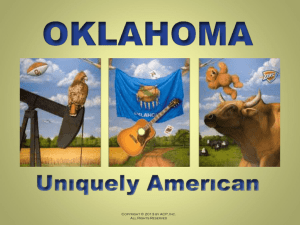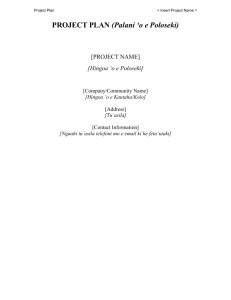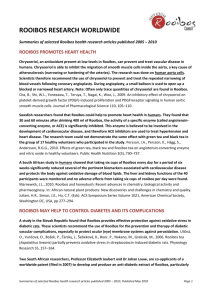Presentation - WordPress.com
advertisement
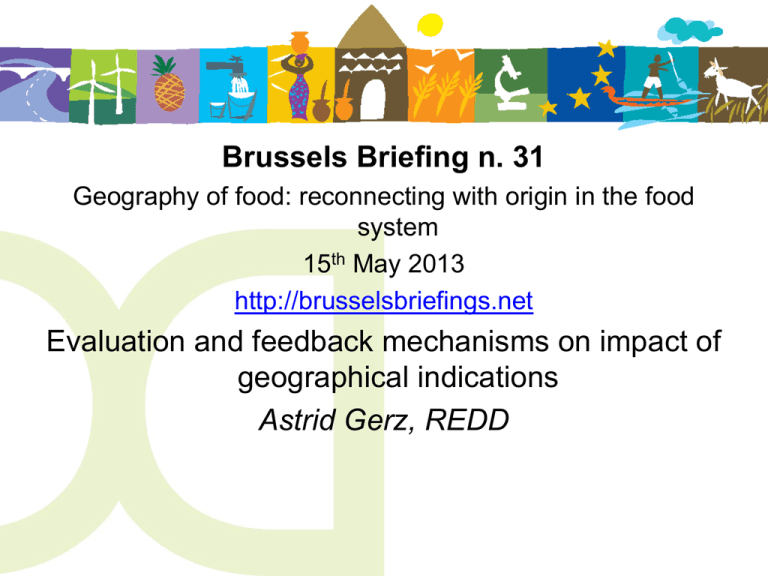
Brussels Briefing n. 31 Geography of food: reconnecting with origin in the food system 15th May 2013 http://brusselsbriefings.net Evaluation and feedback mechanisms on impact of geographical indications Astrid Gerz, REDD Evaluation and feedback mechanisms on impact of geographical indications Expected and Effective impacts/benefits of IP and product branding strategies in ACP countries Astrid Gerz Associated partner and Project manager at REDD Structure of the presentation • Part I What are impacts and why do we need to assess them? • Part II Typology of impacts in ACP countries • Part III Key findings & Conclusions Some basics: Why do we need evaluations? • Transparency and accountability between donors and implementers • Policy and politics • Science and knowledge Some basics: Why do we need evaluations? Policy Development Organisations and Government policies • Need to verify assumptions on development impacts • Means for public and private actors to learn from their experiences and to incorporate them into policy and practice • Robust basis for raising funds and influencing policy In developing countries, still limited science based evidences of the benefits of OLP IP and branding strategies Some basics: Why do we need evaluations? Politics Dispute between members/countries at WTO level to widen the scope of the TRIPS agreement to all food products • Number of countries try to demonstrate the benefit of the Geographical Indications, especially for developing countries and LDC Some basics: Why do we need evaluations? Science and knowledge • Basis for questioning and testing assumptions • Reveal mistakes and offers paths for learning and improvements of the overall approach Need to have impacts assessment for a quantitative representative sample of products (SinerGI data base and FAO case studies for example) Some basics: impact • Impacts Are observed effects …. of the implementation of the Geographical Indication system / protection scheme ... in three main dimensions of the sustainable rural development: economic (fair distribution of the created value, better income), social and cultural (promoting traditions and the cultural heritage, reinforcing the sense of local identity, fighting rural exodus, women and marginal employment), environmental (preservation or improvement of the natural resources, landscape, biodiversity) Some basics: expected impacts • What are expected impacts? objectives/motivations/expectations (positive expected impacts) but also risks (negative impacts) Some examples of GIs potential impact on supply chains - effects on quantities sold (increase due to reputation / decrease due to exclusion of producers?), - effects on prices, incomes (increase due to the willingness to pay of consumers / decrease due to new costs to respect the code of practise? Cost of certification?), - effects on the production concentration (decrease with limitation of yield, size of the process units / increase due to the size restriction of the area?) Compilation from Belletti, Marescotti, WP2 Sinergi, 2006 Some basics: expected impacts difficult to assess • How to assess “impacts” for systems in progress? • Impossible to assess effective impacts • Identify and assess factors which could potentially be impacted by IP and branding strategies • As most of the GI systems are new or emerging, almost all impacts are expected • But certain of these impacts are prevalent in the motivation of the initiators / supporters of a IP and branding strategy 10 Some basics: Do not forget to measure non-expected impacts!! • Non-expected impacts can be positive or negative • Negative impacts can be a threat to the overall sustainability of the value chain Do not limit the assessment of impacts to the objective of the IP and branding strategy Some basics: More about evaluation methods and studies of IP and branding • FAO Quality & Origin programme http://www.foodquality-origin.org/home/en/ http://www.foodquality-origin.org/fileadmin/templates/olq/files/MethodologyEN.pdf • The Effects of Protecting Geographical Indications: Ways and Means of their Evaluation https://www.ipi.ch/fileadmin/user_upload/Juristische_Infos/e/publication_no_7_2nd_ ed_Effects-of-Protecting-Geographical-Indications.pdf • Siner-GI and DOLPHINS for Gis in European Union http://www.origin-food.org/2005/base.php?cat=10&page=10 All links at http://redd.pro/downloads The context of GI in ACP countries: Example of OAPI Motivations (expected impacts) for GI protection in OAPI member states Fight against unfair competition Control markets Rural local development Preservation of cultural heritage OAPI: GI initiatives Wagashi, Huile de Palme de Tsévié BENIN Beurre de Karité de la Sissili BURKINA FASO Café et Cacao du Cameroun, Miel Blanc d’Oku, Poivre de Penja CAMEROUN Riz de Montagnes, Noix de Cajou des Savanes, Mangue de Côte d’Ivoire, Attiéké de Grand-Lahou, Pagnes de Tiébissou, Toiles de Fakaha, Café et Cacao de Côte d’Ivoire COTE D’IVOIRE Café du Mont-Ziama, Belle de Guinée, Piment Mamou, Ananas Manférinyah GUINEE CONAKRY OAPI: GI initiatives Poutargue de Nouahdhibou MAURITANIE Violet de Galmi NIGER Miel de Casamance, Yett du Sénégal SENEGAL Riz de Kovié, Igname de Bassar TOGO Mbong GUINEE EQUATORIALE Oignon du pays Dogon MALI GI in ACP countries: A new concept Few success stories and not enough experience in ACP countries, but possible typology The first class : pepper from Penja (Cameroun), white honey from Oku (Cameroun), coffee fromMount Ziama (Guinea), Blue Mountain coffee (Jamaica), which will become show cases as PDO Comté cheese (France) or PDO Ryebread (Switzerland). GIs registered as trademarks : the Ethiopian fine coffees (Yirgacheffe, Sidamo etc), Rooibos (South-Africa), violet de Galmi (Niger), belle de Guinée, traditional maroon craft products from Suriname (”Maipafolo” mark), Kenyan tea & coffee (certification marks) GI in ACP countries: A new concept Promising GIs, not protected yet: the Wagashi from Benin, the cacao from Cameroun (REDD actually carries out an impact study), the tea from Rwanda, Mukono Vanilla or cotton from Uganda, Demerera sugar from Guyana, Bahamas straw products, cocoa from Trinidad & Tobago Poor economic data on the success, difficult to assess the impacts However, empirically the benefits of GI are obvious GI in ACP countries: Economic impact EXAMPLES OF USURPATION : pepper of Penja (registration tentative in France), Rooibos (registration as a mark by an american enterprsie), Ethiopian coffee (use of trademark coffees by Starbucks) ; registration tentative of the collective mark « galmi » at OAPI (case study 2011) ; Blue Mountain Coffee “Blue Mountain Style” ... from Korea Source: oriGin, Monique Bagal GI in ACP countries: Economic impact • LESSONS LEARNED : « better late than never »; protecting the earliest + protecting in your country as well as in other countries (territoriality principle of IP-rights) • HIGHER PRICES: Pepper from Penja: According to OAPI the selling prices have more than doubled since its labelling; from 2’500 FCA (5 USD) to 6’500 FCFA (13 USD) (besides the fields) Ethiopian fine coffee : According to WIPO, since the creation of the trademark Yirgacheffe and the licensing scheme, farmers income doubled in 2007 compared to their income in 2006 GI in ACP countries: Social impact • BENEFITS : Better organisation of the producers/supply chain actors, fixing populations in their territory, strong community based local • • initiatives (examples:white honey from OKU, Wagashi) LESSONS LEARNED : « the union makes the strength» LIMITS : producers do not have the same resources nor the same opportunities to access the international market even with the GI : CASE OF PEPPER FROM PENJA : between large and small producers in market access: Discrimination Regarding the international market (for most European countries), it seems that no small producer has access (primarily reserved to a few large plantations. Moreover, smallholders do not have access to double certification because of the high costs. This opportunity remains thus the prerogative of the wealthiest farmers. addition, the creation of the GI resulted in an increase in land prices In making those inaccessible to the poorest. GI in ACP countries: Environmental impact • Two excellent examples : ROOIBOS (a program on sustainability and preservation of biodiversityHeiveld-cooperative) honey from Oku: preservation of the forest Kilum Ijim White (reinforcement of the interlinkages between the product and the specific natural resources) • LESSONS LEARNED : Pepper from Penja : GI potentially victim of its success. Risk to give up other cultures for pepper This concern applies to all cultures. GI in ACP countries: Impact on the structuring of the supply chain • Even before the registration as GI, positive effects in terms of mobilisation and organisation of the supply chain actors had been observed during the qualification process of white Oku honey and pepper of Penja: becoming aware about « what is the real product », its quality and values, the geographical limits, etc. A well known example: The success of Argan oil Price of a liter of Argan oil has risen from 3 euros in 1996 to 30 euros in 2008 Promotion of women, capacity building Preservation of traditional landscape Promotion of regional tourism Key findings • Recent studies in Africa and the Carribean revealed the lack of available data to set up the expected and effective economic impact and added value of GIs. • Lack of knowledge on impacts (different levels) of IP and branding strategies in developing countries Important need of evaluation and research • Difficulty to assess expected impacts because of their multi dimension and process long timeframes Key findings • The registration of the GI is dedicated or will dedicate a specificity linked to the origin. Following this, the social and environmental issues can be a challenge for GI producers. That’s why a good lesson can be provided from those of them who have chosen a double certification allowing to recognize their compliance with social and environmental standards on the market... • EX: CAFE DE ZIAMA (GI / FAIR TRADE, PEPPER FROM PENJA (GI / GLOBAL GAP), COCOA FROM CAMEROON (Will be soon a protected GI which is probably combined with a Rainforest or UTZ label). Bottlenecks • Linked to « developing countries » general legal and institutional conditions – Lack of competences and means at institutional level as well as at producers level (for example: certification) – Land tenure insecurity – Short-term (economic) objectives vs long-term environmental objectives – Distribution of power in the supply chain • Specifically linked to GIs – Lack of specific skills in the public institutions and support organisations (for ex. delimitation of the region of origin, determination of core elements of the specificity to be put in the code of practices) Risks • Monopoly – in favour of the most powerful actor in the GI system) – unfair exclusion of certain actors (delimitation of the geographical area / technical constraints) • Additional costs – Small-scale farmers have to pay certification costs or to fit with new technical conditions – Benefits (premium) are captured by out-of-area actors (Tequila) Conclusions about study results Research studies clearly identify the ability of GIs production systems to create positive effects on rural development The protection scheme does not guarantee these positive effects but may reinforce them The registration process should look carefully at the present effects on rural development (economic, social, environmental) The positive effects depend on the strategies that the local and non-local actors undertake General Conclusions Needs for further research/studies Needs for further assistance in terms of awareness raising, training, capacity building More show cases are needed to learn from best practices and go forward in implementing GI and other IP branding strategies for origin products. Combining GI with other voluntary standards (Rainforest/Fair trade / Organic …) to strengthen social and environmental effects and a mutual reinforcement on the market




